Simcha’s Torah
| September 13, 2022Rav Yosef Leizerovitch retraces the path to his special son’s unusual wedding
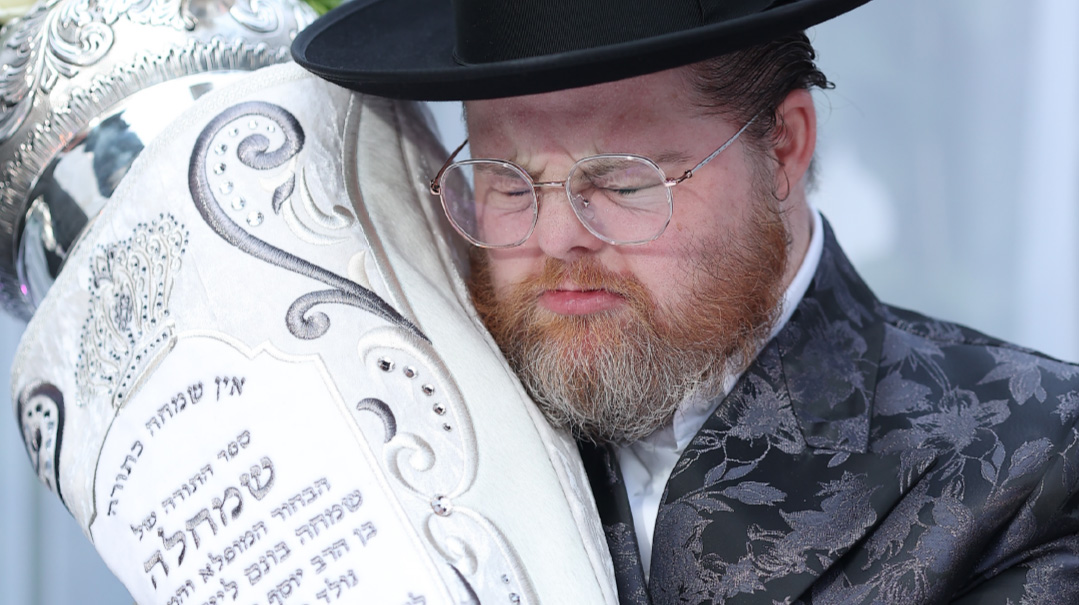
Photos: Itzik Blinitsky, Shlomi Cohen
ATfirst glance you’d think it was another upscale Bnei Brak wedding.
On the synthetic grass outside the Keter Rimon hall, family members huddle together, ignoring background noise from the street and connecting instead to the joy and excitement of their own personal gathering.
There’s the stage with the multi-piece band, the chassidishe choir, and Motti Steinmetz in his shtreimel, his soulful voice pleading as he sings the words from Neilah: “Oy, shaarei Shamayim pesach” — open the gates of Heaven…
But at the kabbalas panim, Simcha’le, the chassan, is signing another kind of kesubah — he’s filling in the last letter in a sefer Torah. And at the badeken, he covers his “kallah” with a pristine white embroidered mantel and places a crown of flowers over her head.
Earlier, he had gone to the Kosel for his “aufruf,” where he received an aliyah and brachos from well-wishers who threw candy at him. He then drove off with family members to visit the graves of his grandparents, and in the time-honored custom, left a “wedding” invitation on their tombstones.
And now, as the procession begins to the traditional strains of the Alter Rebbe’s “Arba Bavos,” Simcha’le stands under the chuppah, flanked by his “unterfirers” — his father and brothers — and their glass-encased candles. Tears mingle with joy, and in the center of it all is Simcha’le, clutching his Torah scroll, beaming and ecstatic, listening as the “mesader kiddushin” sings to him about his kallah, the Torah. Simcha’le is finally having his moment under the chuppah, too.
Simcha’le, who was born with Down syndrome 30 years ago, watched happily as his siblings married, one after another, but his pure soul also yearned for a moment of joy all his own. And now his dream has come true.
Everyone in the audience is emotional, but Simcha’le is beaming as the badchan churns out rhymes about the chassan’s special friends — pure neshamos whose secrets remain hidden by their limited bodies. “May all go well for them, may it be easy for their families. May they be loved and respected, may they be accepted as they are. Amen, amen, amen.”
And suddenly, the slow beat of the chuppah music gives way to the whirling dancing of a hachnassas sefer Torah procession. The chuppah begins moving forward, as Simcha’le and hundreds of his friends accompany it and dance with all their might for the honor of the Torah, with torches, flags, and infectious enthusiasm.
And then comes the “yichud room.” Simcha’le will be honored with reading a few words from the new sefer Torah, he’ll raise it, help roll it up, cover it, kiss it and not let it go until he places it in the aron kodesh.
The celebration, replete with an elegant meal, pulsating lighting and dance music, a collection of popular singers, and hundreds of friends and well-wishers from around the country, leaves Simcha’le euphoric.
It also electrifies the entire country. Everyone who hears about “Simcha’le’s wedding” is amazed by the scale of the production, the famous performers who took part, the dedicated Jews who worked to make it possible, and especially Simcha’le’s own siblings, who masterminded and pulled off a wedding no one will forget.
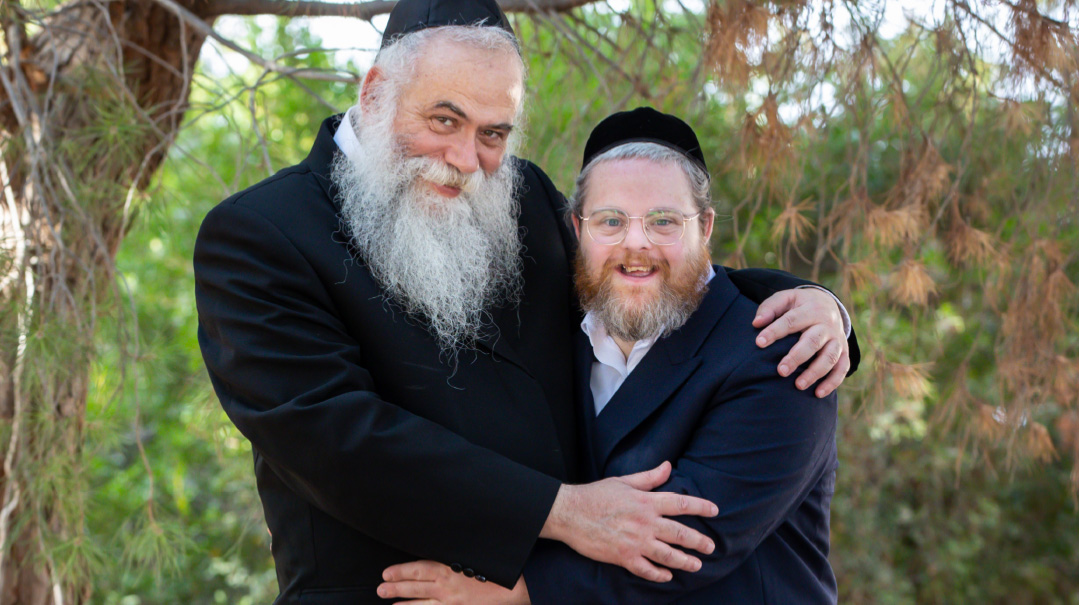
You’ll Tell the Others
Although three decades have passed, Rav Yosef Leizerovitch, rav and posek of Moshav Ohr Haganuz near Meron, can still recall the mixed feelings he experienced when Simcha’le was born. At the time he was a young mechanech and talmid chacham living in the Galilee town of Chatzor, with a busy household of six young children. Simcha’le would introduce the term “Down syndrome” into their personal lexicon.
“Back then,” Rav Leizerovitch recalls, “although there had already been much progress in the realm of special children, there was still less awareness and more fear. Many families still preferred to opt for foster care — the thought of raising these special children was just too intimidating. And of course there were still stigmas and fears about how it would affect the other children’s shidduchim.”
But the Leizerovitches didn’t have the luxury of pondering these questions. First and foremost, they had to fight for their newborn’s life. He was on life support and had to overcome many serious health issues.
Still, as soon as Simcha’le was born, Rav Pinchas Menachem Alter, the Pnei Menachem — who had just become Gerrer Rebbe after the petirah of his half-brother, Rav Simchah Bunim Alter (the Lev Simchah) — called Rav Leizerovitch and instructed him to hold a regular shalom zachar, as he’d do for any other child. The Rebbe added a brachah: “May Hashem help you raise him gleich — as smoothly and easily — as all the other children.”
The bris was delayed, but still, the infant was holding his own and rallying. Meanwhile, as it was Elul, Reb Yosef traveled from Chatzor to Jerusalem to spend a Shabbos with his rebbe and receive some much-need chizuk. Traditionally, thousands of chassidim come to spend Shabbos with the Gerrer Rebbe in Elul, and there’s little time even for pressing questions.
Before taking leave of the Rebbe, Reb Yosef stood in the long line of chassidim and when his turn finally came, he pressed the proffered hand and was about to scurry off, when the Pnei Menahem’s eyes met his.
“Reb Yosef,” the Rebbe inquired, “when are you holding your son’s bris?”
A moment of silence. Rav Leizerovitch didn’t know what to say, as the doctors had not yet given him the green light. And anyway, why was the Rebbe so interested in the bris?
But the Rebbe cut through his thoughts. “I want to participate in the bris. If you already have a sandek or if you’ve already prepared kibbudim for the bris, don’t worry. I don’t need a kibbud. I just want to be there.”
The last thing Rav Leizerovitch wanted was to disturb the Rebbe during this busy time by asking him to travel to Chatzor.
The Rebbe noticed his chassid’s discomfort and quickly added, “It’s before the Yamim Noraim. I want to be with Rabi Shimon in Meron, and so I may spend a few days in the north. Chatzor isn’t far, so I’ll get a bris in as well.”
The Rebbe, it seems, was sending a message, not only to the Leizerovitch family, but to any of his chassidim facing the challenges of raising special-needs children.
“After the Rebbe told me he would come to the bris,” Reb Yosef recalls, “I asked him, ‘And what should we name the child?’
“The Rebbe replied, ‘Exactly the same name that you intended before his birth.’ I told him that we had intended to name him Simchah Bunim, after the Lev Simchah.
“The Rebbe was very enthusiastic. ‘Simchah Bunim is definitely good. The Rebbe, zichrono livrachah, vet zicher zein shtark tzufrieden [would surely be very pleased]. At home you should call him Simcha’le. He’ll be happy, and he’ll bring simchah.”
After the bris, the Rebbe told Rav Yudel Leizerovitch, Reb Yosef’s father and a confidant of the Rebbe, “I saw the child. He looks very good, much better than I expected. You’ll see great nachas from him yet.”
The Pnei Menachem would have many more conversations with Reb Yosef about Simcha’le’s development. “I’m telling you all this so that you’ll tell others,” the Pnei Menachem told his chassid after one of those conversations. And indeed, the Leizerovitch family has never stopped “telling others” — hardly an evening goes by without a phone call or visit from another family tasked with this special mission.
“People to whom Hashem gives this gift need practical direction and guidance,” the Rebbe once told Rav Leizerovitch. “When most people hear of a family that has received this challenge, they try to encourage them and cheer them on. But that’s not the point. More than chizuk, these struggling families need direction. Parents of such children often feel lost — they have no idea what to think, how to approach their challenge. They don’t know what’s right and what’s wrong. Some are ashamed. They might be under pressure from their immediate families. These people are creating a lot of unnecessary pain for themselves, piling on so much extra mental anguish. So the first thing you need, even before encouragement, is guidance.”
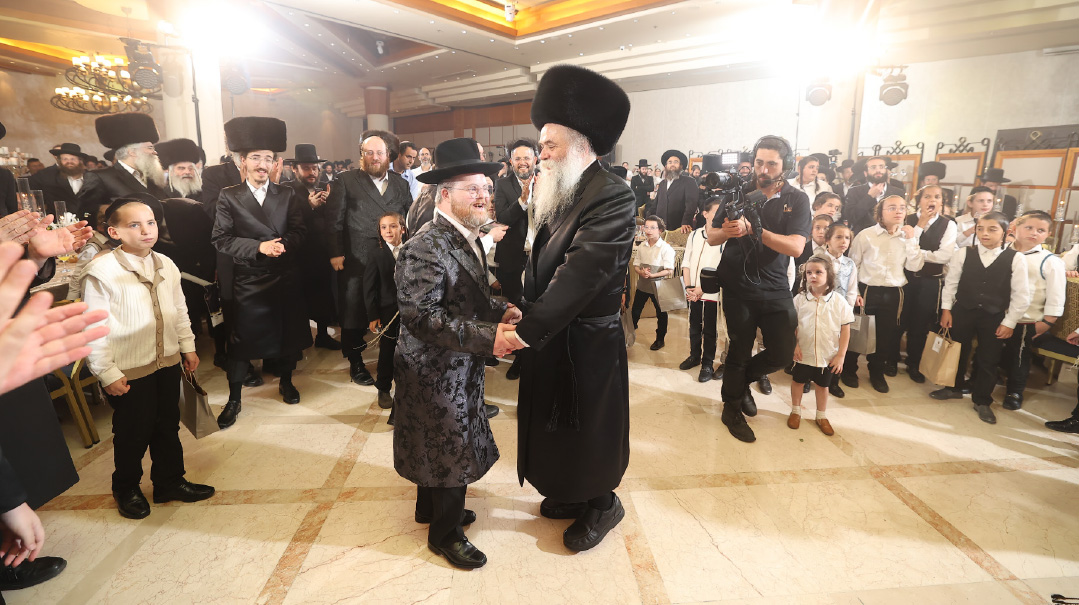
All His Children
“We really took the Rebbe’s message to heart,” says Reb Yosef. “Right from the beginning, we knew that not only would we not hide our Simcha’le, but on the contrary, we would ‘market’ him. The first thing was not to be frightened. No, he wouldn’t impact anyone’s shidduchim, or any sibling’s mental health. There would be no concealment and no shame.
“And in fact, Simcha’le’s brothers and sisters were never ashamed of him. On the contrary, they would bring him along to their games and to their friends,” Reb Yosef continues. “At every family simchah, he always danced in the center of the circle and was never sidelined. We followed the Rebbe’s directives. The situation was challenging enough, there was no need to add more aggravation on top of it. Hashem wants us to accept His judgment with joy and without regret. And we’re not talking just about in the realm of ruchniyus. Acceptance is a key to mental health as well.”
When people are faced with the challenge of special-needs children, the first question they ask is: Why us? The Rebbe gave the Leizerovitches a clear message — that under no circumstances should the parents think that this happened to them as a punishment, either for this gilgul or for a previous one.
“According to the Rebbe, it should be seen as a special shlichus. That doesn’t mean you have to deny your pain or put any agmas nefesh on the back burner. All the complicated feelings also have to be acknowledged.
“I’ll never forget the Rebbe’s Shabbos Shuvah tish at the beginning of 5755 (1994). The Rebbe spoke about the mitzvah of Hakhel, how every seven years after shemittah, all of Am Yisrael would assemble in the Beis Hamikdash — men, women and children — to hear the reading of the Torah. But the Gemara has a question: The men came to learn and the women came to hear. But why the small children — ‘taf lamah ba’in?’ Why schlep the little ones, who don’t understand anything anyway? To which the Gemara replies: ‘Kedei litein sechar l’mevi’eihen — to give sechar to the parents who went to the trouble of bringing them.’
“The Rebbe did a little pilpul on this Gemara and suddenly raised his voice. He seemed to be talking about some particular cases that had come to his attention. ‘Sometimes,’ the Rebbe said in a choked voice, ‘children come into the world only to leave it shortly thereafter. And sometimes children are born with diseases and handicaps whose purpose no one can understand. And the question cries out to the heavens: Ribbono shel Olam, taf, lamah ba’in?! What is the purpose for which these souls came into the world? And the answer,’ the Rebbe continued, ‘is kedei litein sechar l’mevi’eihen — to give reward to the parents who bring them in holiness.’ And the Rebbe ended his remarks by adding: ‘These children strengthen the other siblings, other neshamos — and bring a benefit to all of Klal Yisrael.’
“But I’m a simple Jew,” Reb Yosef continues. “I don’t deal in deep secrets. I’m not in a position to talk about ‘neshamos.’ I can only repeat what I heard from the Rebbe zechuso yagein aleinu: ‘Hashem loves all children — but He especially loves these children.’ I don’t understand the deeper meaning, but I can talk about what we can all see with our own eyes. We’re simple people, and the world is deeper and more complex than we are. We can’t be sure that we’ll ever find out — in this life — why we were chosen and what our mission really is.
“At every wedding, we say the brachah ‘shehakol bara lichvodo.’ And this means that Hashem needs every creature He placed in His world. Every such child adds to His glory, even if we don’t understand how. There are plenty of other things we don’t understand. There are many mysteries even in the supposedly ‘normal’ world. Researchers investigate why every species of butterfly is necessary. There’s no shortage of creatures that at first glance seem to contribute nothing to the universe and seem to be redundant. But this is mistaken thinking. Hakadosh Baruch Hu doesn’t create mutations by mistake. Everything has a purpose. Shehakol bara lichvodo. HaKadosh Baruch Hu needs them all.”
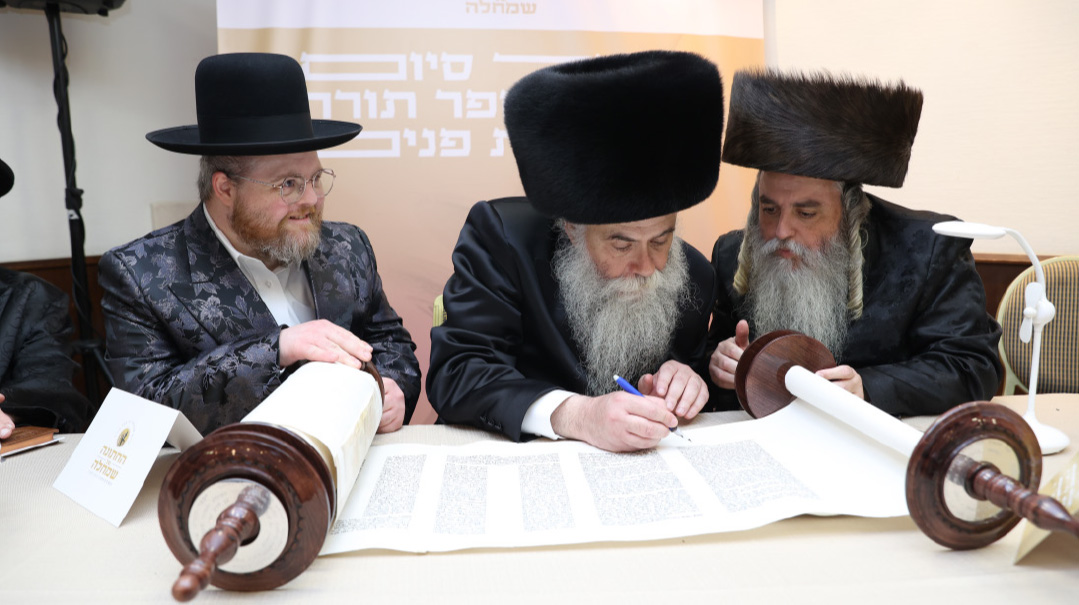
Key to Blessing
Rav Leizerovitch doesn’t want any misunderstandings, though. He clarifies that acceptance doesn’t mean repressing or ignoring the pain. “True, there are many difficult and painful moments,” he says. “You’re allowed to cry, and you should cry when you’re in pain. Just don’t lose your way.”
But what to do about young family members who have yet to attain this nuanced worldview? How do you teach the rest of the family about their special baby brother?
Reb Yosef rewinds back to those first days, when he grappled with this very question.
“We weren’t sure how much to tell our other children,” he remembers, “but the Rebbe raised this question himself in our very next conversation. ‘Very likely,’ he said, ‘you’re debating whether and how to tell the other children about it.’
“And then the Rebbe started working through the dilemma with me, how to take into account the needs of the other children and make sure they don’t get hurt in the process. ‘On the one hand,’ the Rebbe said, ‘the siblings need to know what’s going on with their brother. But on the other hand, they’re so young. How much do they really understand? Technical explanations will only frighten and embarrass them.
“‘Perhaps it’s best to let them become acclimated to the reality on their own — without giving it a scary name. Simply by living with their little brother, they’ll get used to his situation and come to terms with it in a more natural, organic way.
“‘But still, there is a risk. One day, one of your children might go out to the park and a neighborhood boy will suddenly tell him, “You know you have a crazy brother, a Mongoloid!” And the child could become very embarrassed. But you know what? I’m not going to think about that possibility option, because I don’t want to think about a Yiddishe child acting so cruel. So just tell the children that they have a brother who’s a little different. The rest they’ll learn for themselves in time.’”
Rav Leizerovitch doesn’t believe in sugarcoating the challenges. “Any time there’s a special-needs child at home,” he says, “it means the family has a choice. It can be the key to blessings and shalom bayis or it can, chas v’shalom, be a catalyst for dragging the household down. I know people who ruined their own lives because they walked around with an initial assumption that this special child would eat away at their parnassah, destroy their happiness and hurt them in shidduchim — and unfortunately, this often becomes a self-fulfilling prophecy.
“Those of us blessed with healthy children often expect our children to fulfill our dreams, and that can launch a vicious cycle of pressure and unhealthy expectations. But with Simcha’le in our family, there were no expectations. We suddenly learned to appreciate every little achievement, even a minuscule success. And most importantly, we learned the most important element in parenting — the bedrock knowledge that a child is still a child, no matter what he does and how much he succeeds.
“I believe Simcha’le strengthened our family unit, and I’ve seen many other families where these children have been a key to blessing. As in every area of life — when it comes to ‘normal’ children as well — we have a choice. And the Torah implores us, u’vacharta bachayim — choose life. Don’t victimize yourself, and don’t see yourself as a victim. With Hashem’s help, you can take on the challenge with grace and confidence.”
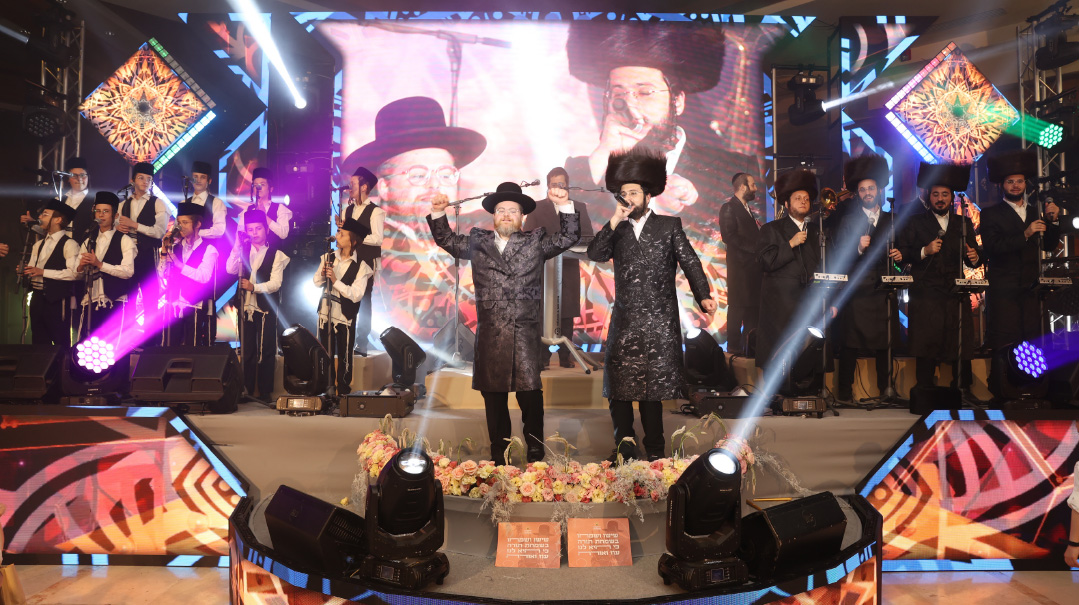
First and Last
Perhaps a few eyebrows were raised at the photos and video clips of “Simcha’le’s wedding.” You might have even seen some of them yourself. If the opulence, the expense, and the flashy production rubbed some people the wrong way, they might have missed the point.
“There was definitely an important message here,” explains Moti Leizerovitch, Simcha’le’s brother and the main coordinator of the event. “It wasn’t just for Simcha’le, but for all the special-needs children out there, and for their families too. Let them copy our example. Let them not be ashamed of their Simcha’les, but celebrate them instead.”
“The responses we got the day after the wedding were overwhelming,” says Reb Yosef. He tells of an old friend who faced a similar challenge but handled it in a very different way. “He told me that the whole night after the ‘wedding,’ he cried, thinking to himself, ‘Where’s my child, where’s my Simcha’le?’ Instead of crying, I told him, you can still get up and make changes. It’s never too late.”
One fellow told Reb Yosef how he gathered his shocked children around the table and told them that they, too, had such a brother they’d never met, who was growing up as the foster child of another family.
At the “wedding,” Reb Yosef didn’t ignore the elephant in the room, the sequel that will never come. “The first time I gave voice to this idea,” he says, “was at the funeral of a special child. Standing in front of the young meis, I thought about what we say on Rosh Hashanah — that HaKadosh Baruch Hu tells us: ‘I am the first and the last.’
“An ordinary human being is like a link on a chain — sandwiched between two generations, the generation that came before and the generation that will come after. But there are exceptions.
“Take, for example, a ger tzedek whose biological parents are gentiles. Such a person does not have any links before him. And he comes before HaKadosh Baruch Hu and cries: ‘Everyone has yichus, except for me.’
“And Hashem replies: ‘You don’t need yichus, you’re clinging to Me. I’m first, and you’re first too. Your neshamah is part of Me.’
“Then there are children who descend from a long and glorious chain of generations, but the chain ends with them. They will never have children of their own. Their souls come and cry in front of the Kisei Hakavod, ‘Where is our eternity? Why don’t we get to continue our chain? Is it our fault?’
“And the Almighty replies to them, ‘I am the last, and you are the last too’ — you are clinging to Me. The chain may stop with us, but we still remain eternal.”
It’s written that in the future, Hashem will heal every soul and every body. “In the meantime,” says Reb Yosef, seeing the image of Simcha’le under the chuppah, embracing his Torah with such simple and unadulterated faith, “we pray that all Yidden will be able to embrace their individual missions from a place of emunah and connection and love.”
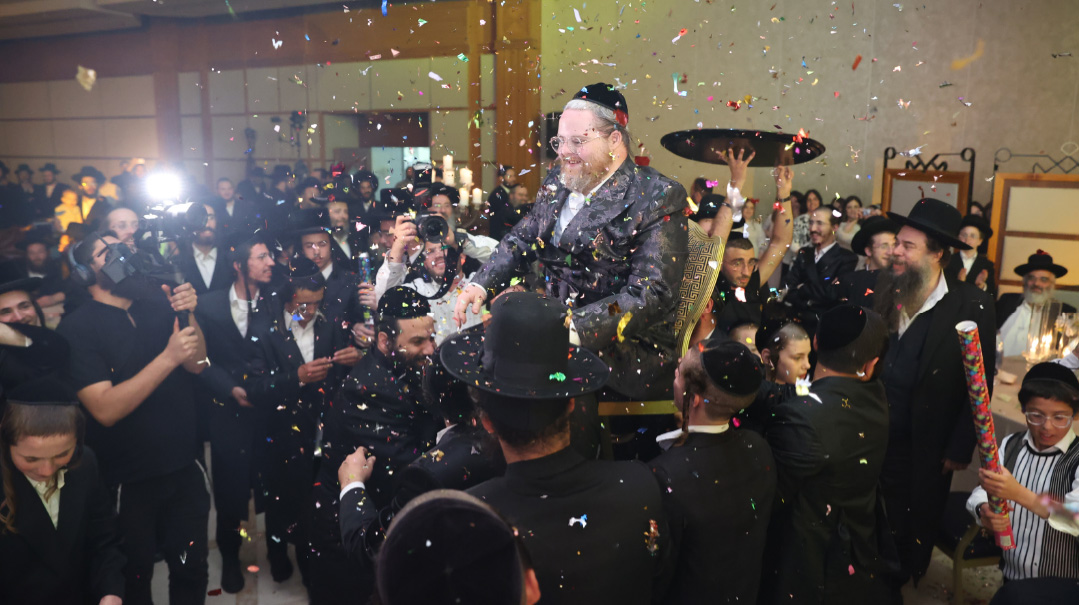
(Originally featured in Mishpacha, Issue 928)
Oops! We could not locate your form.







